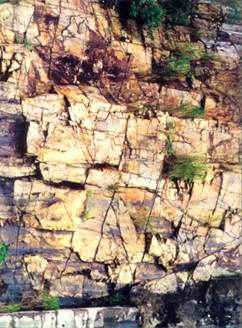Strength and deformability of fractured rocks
PhD thesis defence
Date: Tuesday, 25 November 2014
Time: 10:00
Location: Hall F3, Lindstedtsvägen 26, KTH
Doctoral student: Majid Noorian-Bidgoli
Supervisor: Lanru Jing
Opponent: Prof. John A. Hudson, Imperial College of London, UK
The research was conducted at the Division of Land and Water Resources Engineering , KTH. The thesis is available here .

ABSTRACT
Knowledge about the strength and deformability parameters of fractured rocks is one of the crucial issues for design, construction, operation, and performance/safety assessments of surface and subsurface structures in civil and mining engineering. The fractured rock masses consist many non-uniform and non-regular fractures of varying sizes, orientations and locations with complex fracture system geometry and large uncertainties. However, the proper characterization of these properties of fractured rocks is impossible directly at present using the current laboratory test facilities that are designed for testing small intact rock samples. Large-scale in-situ field tests are not practically feasible due to difficulties in the definition and control of the initial and boundary loading conditions at representative elementary volume (REV). This research developed a systematic numerical modeling framework to simulate the stress-deformation and coupled stress-deformation-flow processes by performing uniaxial and biaxial compressive numerical experiments on fractured rock models with considering the effects of different loading conditions, different loading directions (anisotropy), and coupled hydro-mechanical processes for evaluating strength and deformability behavior of fractured rocks. A stochastic analysis was performed to quantify the variations of strength and deformability of fractured rock, using multiple realization models of the fracture system geometry.
By using code UDEC of discrete element method (DEM), a series of numerical experiments were conducted on two-dimensional (2D) discrete fracture network models (DFN) at an established REV based on realistic geometrical and mechanical data of fracture systems from field mapping at Sellafield, UK. The obtained stresses and strains results from the numerical experiments were used to represent the stress-strain behavior of fractured rocks as a function of confining pressure, and to estimate the equivalent directional Young’s modulus and Poisson’s ratio as two important deformation parameters. The results were used to fit the Mohr-Coulomb (M-C) and Hoek-Brown (H-B) failure criteria, represented by equivalent material properties defining these two criteria.
The results demonstrate that strength and deformation parameters of fractured rocks are dependent on confining pressures, loading directions, water pressure, and mechanical and hydraulic boundary conditions. Fractured rocks behave nonlinearly, represented by their elasto-plastic behavior with a strain hardening trend. Analysis of the stress-deformation of fractured rocks with the axial stress and axial velocity loading conditions shows that there are differences between strength curves and strength parameters under these loading conditions. The results obtained from the rotated DFN models indicate that strength and deformability of fractured rocks are direction-dependent, vary with the loading conditions. Therefore, the directional variations (anisotropy) of strength and deformability of fractured rocks must be considered in practice. The numerical results of modeling fluid flow in fractured rocks under hydro-mechanical loading conditions show an important impact of water pressure on the strength and deformability parameters of fractured rocks, due to the effective stress phenomenon, but the values of stress and strength reduction may or may not equal to the magnitude of water pressure, due to the influence of fracture system complexity. The results of stochastic analysis indicate that the strength and deformation properties of fractured rocks have ranges of values instead of fixed values, hence such analyses should be considered especially in cases where there is significant scatter in the rock and fracture parameters. These scientific achievements can improve our understanding of fractured rocks’ hydro-mechanical behavior and are useful for the design of large-scale in-situ experiments with large volumes of fractured rocks, considering coupled stress-deformation-flow processes in engineering practice.
Key words: Fractured crystalline rocks; Numerical experiments; Discrete element methods (DEM); Discrete fracture network (DFN); Representative elementary volume (REV); Coupled hydro-mechanical processes; Anisotropy; Effective stress; Failure criteria; Stochastic realizations.